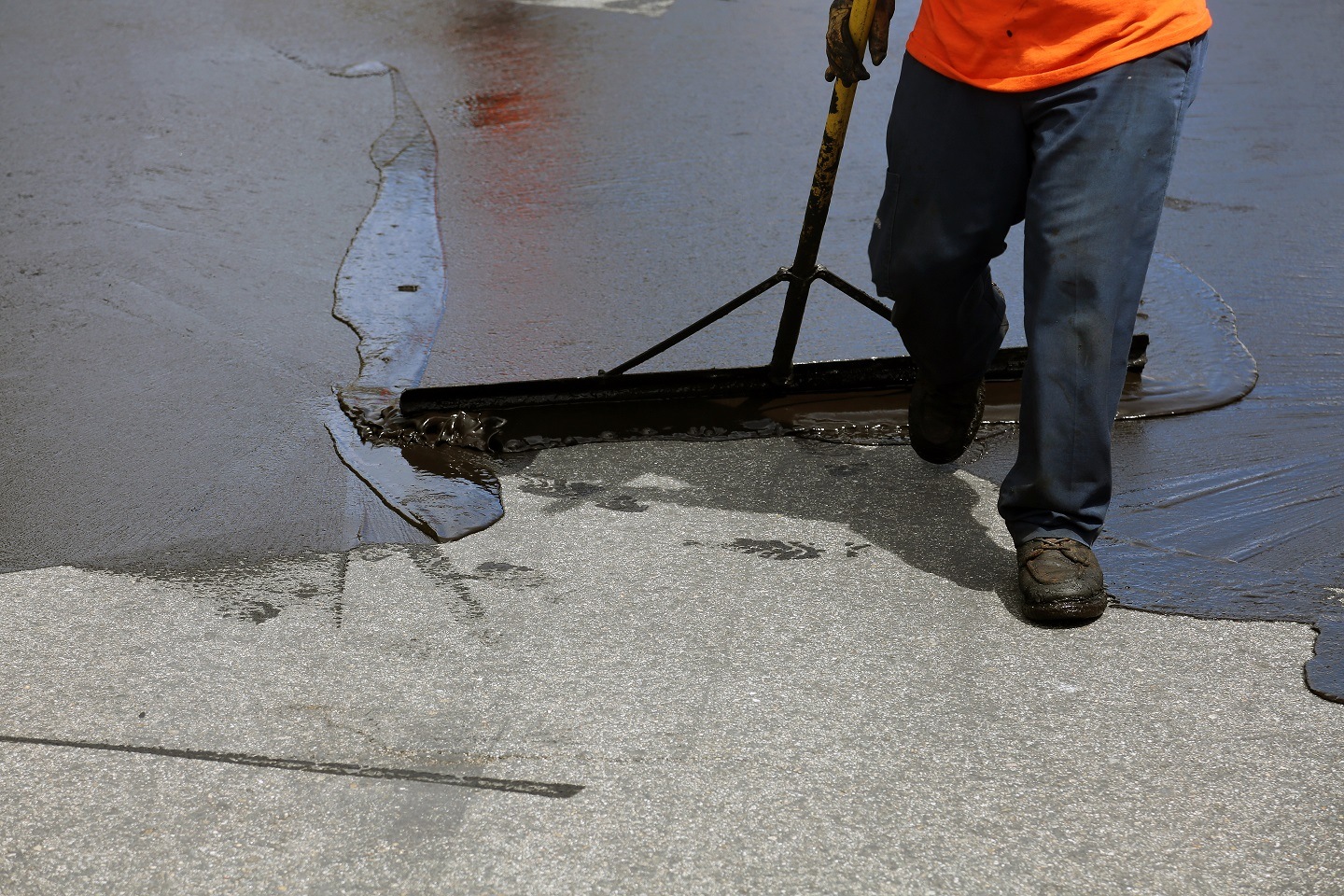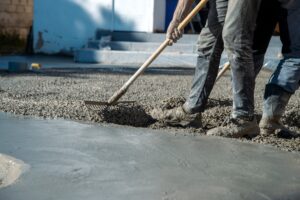As a property manager, you have the power to save your property owners thousands of dollars in future repairs just by sealing asphalt parking lots, driveways, and private roads. But, if you are unfamiliar with asphalt seal coating, knowing exactly what your purview is can be difficult to grasp. In this post, we’ll provide an overview of sealcoating, including benefits, when to seal, and 10 sealcoating tips for property managers preparing to work with seal coating companies.
Sealcoating Basics
Seal coat is a protective material applied to asphalt’s surface to make it last longer. While asphalt can last 15 to 20 years unprotected, it can last up to 30 years or more if you take care of it with regular cleaning and maintenance.
To seal asphalt, seal coat material is applied via squeegee and brush or with a special spray machine. Asphalt coating products are applied cold. It takes 24–48 hours for the water to evaporate out of the coating until it is considered cured and ready for traffic. It can be applied in one or multiple coats.
Benefits of Sealcoating
Sealcoating is a staple of asphalt maintenance because of its many benefits. It protects asphalt, saving property owners money in the long run, and it looks great. Before we move on to sealcoating tips for PMs, let’s look at each of the major sealcoating benefits.
Sealcoating Protects Asphalt
While it may not seem like something that needs protecting, unsealed asphalt becomes brittle faster, and cracks more easily. Sealcoating protects asphalt from the following:
- UV rays
- Fuel spills
- Frost heave
- Raveling
- Snow accumulation and removal
- Oxidation
- Standing water
While everything in this list has the potential to break down asphalt, the biggest threat is water. If your asphalt has any cracks, water will get in and lead to further problems. For example, potholes form when water seeps through pavement cracks, rests underneath the asphalt’s top layer, and then expands as temperatures drop. The water puts pressure onto the top layer of asphalt, causing eventual failures with the normal use of a parking lot or road.
Read More: Parking Lot Sealcoating is Vital. Here’s Why…
Sealcoating Saves Money Over Time
Not only does a properly applied seal coat slow your pavement’s aging, but it also saves money in the long run. By keeping the surface level of your asphalt intact longer, you can stave off more expensive asphalt repairs, like those that require removing and replacing patches of asphalt.
The cost to maintain a typical suburban driveway with sealcoating versus having to remove and replace an asphalt driveway is estimated to be 75% less, throughout a 30-year mortgage. Likewise, for a typical commercial parking lot, the estimated cost to maintain with sealcoating is about 75% less as well, according to the Pavement Coatings Technology Council.
Sealcoating Improves Aesthetics
On top of the long-term cost savings, a freshly coated parking lot returns pavement to a dark matte finish, which is pleasing to the eye. The dark coating also helps attract the sun during the winter, to more quickly melt away snow, and avoid pooling water.
While it is a thin layer that adds less than 1/8 of an inch to the depth of your asphalt, sealcoating makes the surface smooth, filling in small gaps in the pavement’s surface with aggregate.
In parking lots, sealcoating means that it’s also time to restripe. The asphalt’s new, dark finish has the added benefit of making your new striping stand out, adding clarity and safety for your tenants and the public.
Read More: Why Parking Lot Sealing and Striping Go Hand in Hand
When to Sealcoat Asphalt
One of the biggest sealcoating tips is that asphalt shouldn’t be covered with a seal coat as a catch-all. It’s not a universal fix. It needs to be applied at very specific times in your asphalt’s maintenance lifecycle.
Brand New Asphalt
New asphalt shouldn’t be coated right away, but it still needs to be in the budget. It needs some time to properly cure. But, it should be sealed within the first year. You want to seal asphalt when it is fairly new, before any cracks and surface breakdown have had time to happen. Applying asphalt sealers within the first year also helps to maintain asphalt’s oil content which keeps it from becoming too brittle.
Read More: When to Seal New Asphalt (And Why You Must Wait)
Resealing Asphalt
Sealcoating should be done every 3 to 5 years. Easy said, but how do you know which end of the spectrum the asphalt under your care is in?
Seal coat material applied to a more intact asphalt surface will perform better and have a longer life. It echoes the condition of the asphalt structure you applied it to. Higher quality and condition mean longer sealant life.
If your asphalt has cracks and raveling, then crack sealing and other possible repairs need to be made before sealcoating takes place. Additionally, crack sealing should be done about twice as often as sealcoating.
It’s best to seal before winter to avoid unnecessary potholes come spring.
Read More: How Often Should You Seal Coat Your Driveway
10 Sealcoating Tips & Reminders for Property Managers
As a property manager, here are a few tips and reminders to help get ready for an upcoming professional asphalt coating job:
1. Check the weather — Asphalt sealer should be applied to dry asphalt in 55+ weather.
2. Get the sprinklers turned off 24 hours before and 48 hours after your seal coat is applied.
3. Trim the grass so it is off of the asphalt — but don’t do it the same day. Grass particles can blow onto the pavement, get stuck, and impede the seal coat from sticking properly.
4. Move everything off of the asphalt, including portable storage sheds, wooden pallets, boats, and broken-down cars.
5. Notify tenants a few weeks before and then the week of the scheduled maintenance. If you are serving large areas, such as HOA sealcoating, consider notifying tenants with a color-coded map showing which sections will be serviced on each date.
6. Provide crew access — Make sure any locked areas are accessible to the asphalt crew.
7. Stick around or leave someone in charge. It’s best to have yourself or a decision-maker on-site and available while the work is being performed, in case the crew has any questions.
8. Rope off the affected area and access points before the team’s arrival with caution tape and traffic cones.
9. Budget for sealcoating asphalt every 3-5 years (and don’t forget re-striping).
10. Never seal over potholes and large cracks.
One Part of an Asphalt Maintenance Schedule
Sealcoating is important and makes a huge impact on the length of your asphalt’s use, and its appearance. However, it’s just one part of keeping up your asphalt’s appearance. It should be done in conjunction with crack sealing, cleaning, and more. We hope these sealcoating tips help!
If you aren’t sure whether sealcoating is a good option for you or need help putting together an asphalt maintenance schedule, Superior Asphalt, LC can help! We perform asphalt maintenance, repairs, and striping across 5 states: Arizona, Colorado, Nevada, Utah, and Wyoming. Contact us today!




